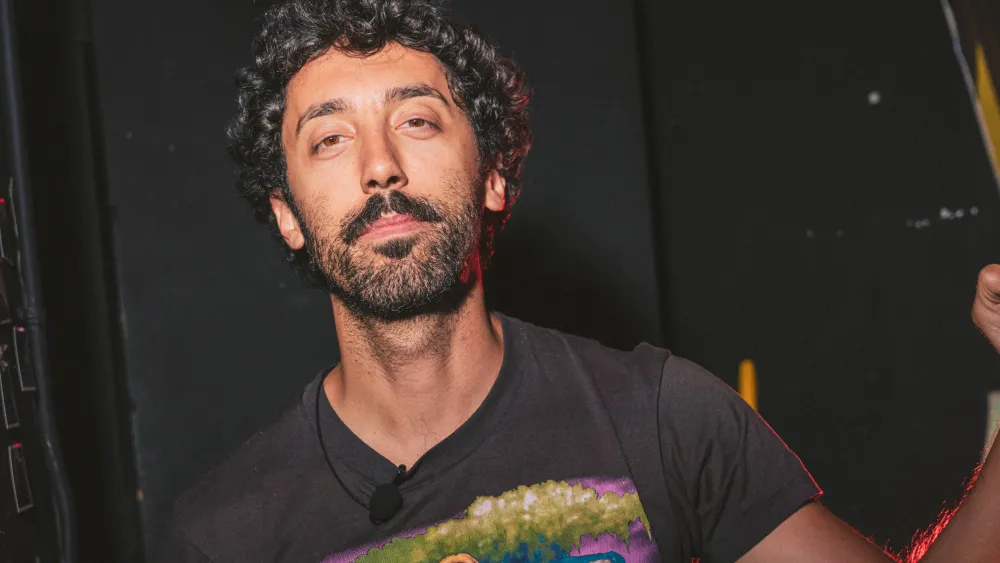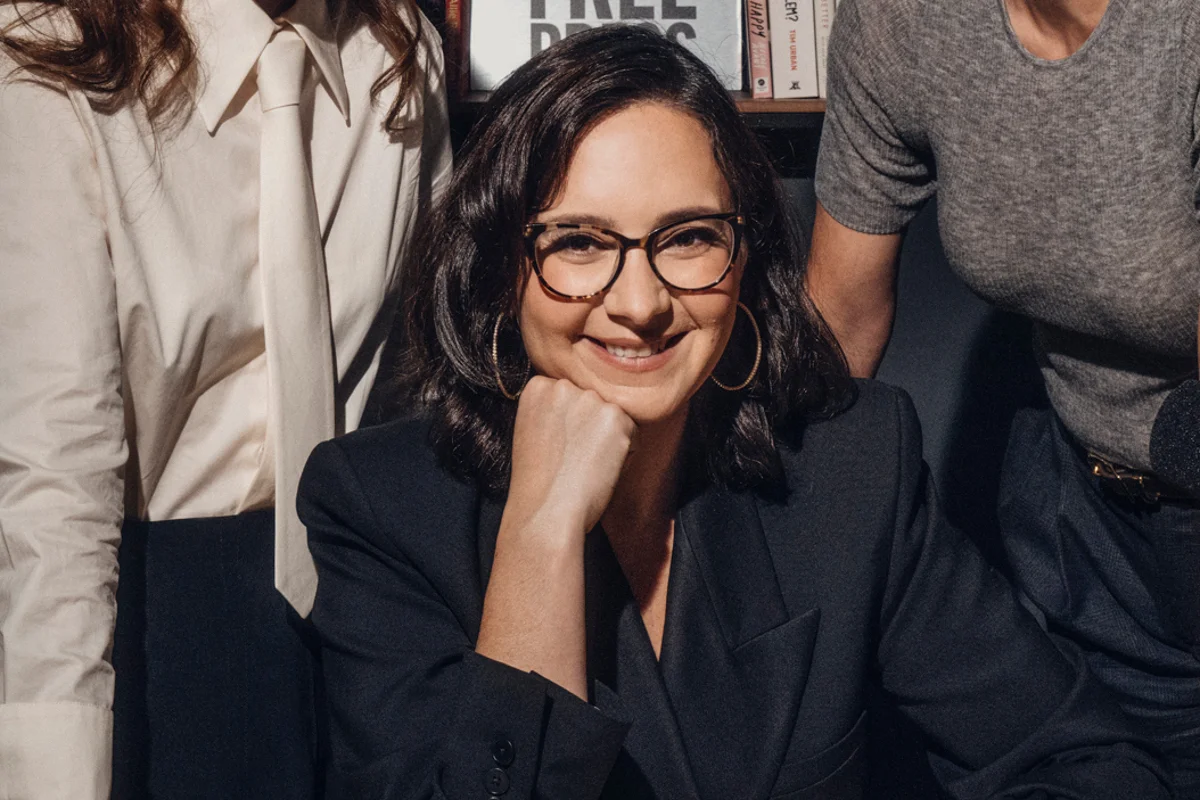Copyright Variety

Morgan Jay is not your typical stand-up comedian. Armed with an acoustic guitar and autotune-drenched microphone, he sprints down the aisles of the theaters in which he performs, bantering with his fans and leading them in song. He pours tequila shots into women’s mouths straight from the bottle, convinces couples on first dates to give each other a “smooch” and pushes wheelchair-bound audience members across the venues, recruiting “baddies” to sit on their laps. All the while, he stares directly into the lens of a roaming camera that follows him around and projects his face onto a jumbotron. He’s got a health and fitness regimen equipped for a pop star: “Running every other day, gym every other day, yoga, 20 minutes of stretching a day, vocal exercises every day when I’m touring, no alcohol, no weed, no smoking whatsoever, no meals after 8 p.m.” “It’s an investment for people to come to the show,” Jay says. He does some math: tickets plus parking plus merchandise plus two drinks plus hotel can easily total more than $500. “I’d hate to not be able to give my fans the best show I can give them.” Jay’s set combines two things that comedy purists might scoff at: music and crowd work. Still, his shows — and the viral clips they birth — have catapulted him into one of the fastest-growing acts in live comedy. This week, he performs three headlining shows at the New York Comedy Festival, plus three additional sold-out dates in New Jersey. The 10-day fest is a homecoming for Jay, who grew up across the Hudson and got his start doing open mics in the city. “I never really considered myself a comic’s comic, so it’s cool to come back and do venues this big,” he says. Case in point: With nearly 15,000 tickets sold in the New York area this week, Jay says he “could have easily sold out Madison Square Garden.” But after a decade of doing open mics, he’s still seeking a sense of belonging in the clubs. In October, he asked his agent if he could audition for the Comedy Cellar, which seats only a couple hundred people. Jay performed at the legendary Greenwich Village club as part of a lineup that featured stand-up vets like Judd Apatow and Louis C.K. He was, predictably, the only comic strapped with an acoustic guitar. “Nobody respects musical comedy until somebody does it really well,” Jay says. He follows in the footsteps of hybrid acts like Steve Martin, Adam Sandler, Flight of the Concords, Reggie Watts and Bo Burnham. Just as Burnham might be the quintessential comic to rise from YouTube, Jay embodies comedy’s TikTok era. He posts about one crowd work clip per day to his 9.4 million followers, asking people where they’re from, who they’re with and whether they will sleep together after the show, all while talk-singing into a pitch-corrected mic. It sounds like if “808s & Heartbreaks”-era Kanye West made raunchy small talk with strangers. While Jay has become famous for these audience interactions, he says it only comprises the first 20 minutes of his set. The rest of his show follows a more rigid structure, with pre-written songs and interludes of traditional stand-up comedy — and no, the autotune is not always on. “Most of my fan base has found me on platforms where they can only watch me for 30 seconds to three minutes per clip,” he says. “The goal is, how do you take that dopamine hit and transform it into a 70-minute show?” For many of his fans, Jay recognizes that his show is their first introduction to live comedy. He leans into his younger demographic by treating his performances more like concerts. While many comics require phones to be sealed in pouches to avoid leaks, Jay allows his audience to take out their cellphones and film him. And he’s not only performing to the crowd, he’s performing to the camera behind him, which makes it so even the nosebleeders can get a good view of Jay on the jumbotron. It also allows him to clip-farm from his own shows, turning his tour into a self-fulfilling “marketing machine.” As he puts it: “I’m looking into the camera for those people who are watching in their bed at night.” Growing up, Jay was the youngest in his family and a self-described “attention seeker.” From an early age, he realized he was not destined for a “normal job.” He studied theater at New York University and, on his second day of college, signed up for an open mic night. “I thought the audience was going to be like 20 people, but there were 400,” he says. He remembers crushing his first five-minute set, which included jokes about morning wood and how it would make more sense if Spider-Man shot webs out of his butthole. “I did really well, to the point where people recognized me on campus,” he recalls. “Looking back on it, I’d probably cringe.” Soon, Jay became addicted to doing open mics, hopping between multiple venues in one evening. “I felt like Superman with a secret identity going out at night,” he says. Even before he played guitar on stage, he leaned more into music lineups because “it was a more welcoming environment,” and he could be allotted up to 20 minutes at some shows, which is quadruple what he’d get at comedy venues. After college, Jay earned an internship as a production intern at NBC’s “The Tonight Show” during its single season hosted by Conan O’Brien. Working at the late-night program taught him “how to be a ruthless editor of my own material.” “Conan would have three or four pages of jokes for the opening monologue, and the interns were asked to come down and watch him rehearse, so he could get a live reaction,” Jay says. “He’d read the jokes and immediately go, ‘No, no, no, no, yes, no.’ He wasn’t precious with material.” Around the same time, Jay was continuing to perform and repeatedly auditioning for Just for Laughs. He was getting bored of his own set and had a revelation, asking himself: “Would I buy a ticket to my own show?” He had always sang and played guitar, and a friend suggested he incorporate it into his live act. He spent the summer writing songs and revamped his set, gigging at night while working various day jobs. After “The Tonight Show,” Morgan was a bike tour guide, where he’d plug his own shows to tourists cycling around Central Park. And then he got a job hawking iPhones. “90% of working at the Apple store is resetting passwords,” he says. But the gig did train him on digital editing and production software, which would later come in handy. When Morgan was 20, he made a contract with himself that he would stop performing comedy if he couldn’t make money within 10 years. “It was right around the 10-year mark where I quit my job at the Apple store, booked 40 colleges for the next year and a couple commercials. From that point on, every year got progressively better.” The pandemic was a turning point for Jay’s career. He concocted his signature recipe — the autotuned crowd work — while trying to spice up corporate Zoom gigs. The pitch correction became a mainstay of his live show, a sonic barrier that gives his audience the confidence to let loose and sing and chat with him. As the comedian says, “It allows anybody in the crowd to be like Travis Scott.” Now, Jay tours around the world, from Dubai to Spain to Australia. In Brazil, he even performed half of his set in Portuguese. He has noticed Morgan Jay dupes pop up in certain places. “People send me videos,” he says. “There’s a guy in India doing what I do. There’s a guy in Germany, a guy in South Korea. It’s flattering.” He’s especially grateful that his viral success was coupled with a decade of grinding at open mics. “When I started going viral on TikTok, thank God I had 10 years of experience and a backlog of material,” he says. “There are people who blow up on TikTok who don’t have 20 minutes of material.” Looking ahead, Jay has his sights set on arenas, and he’s hoping to do more acting. He recently filmed a part in a movie from Live Nation Productions and will appear in the Chloë Grace Moretz and Anthony Ramos rom-com “Love Language.” Plus, he’s developing an original TV series with A24 that will have a musical element. “People just see me as this TikTok comedian,” he says. “There are a lot of other sides of myself I’d like to show.”



